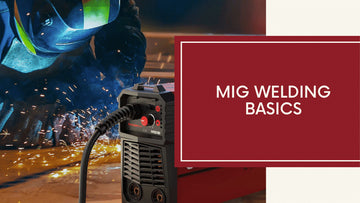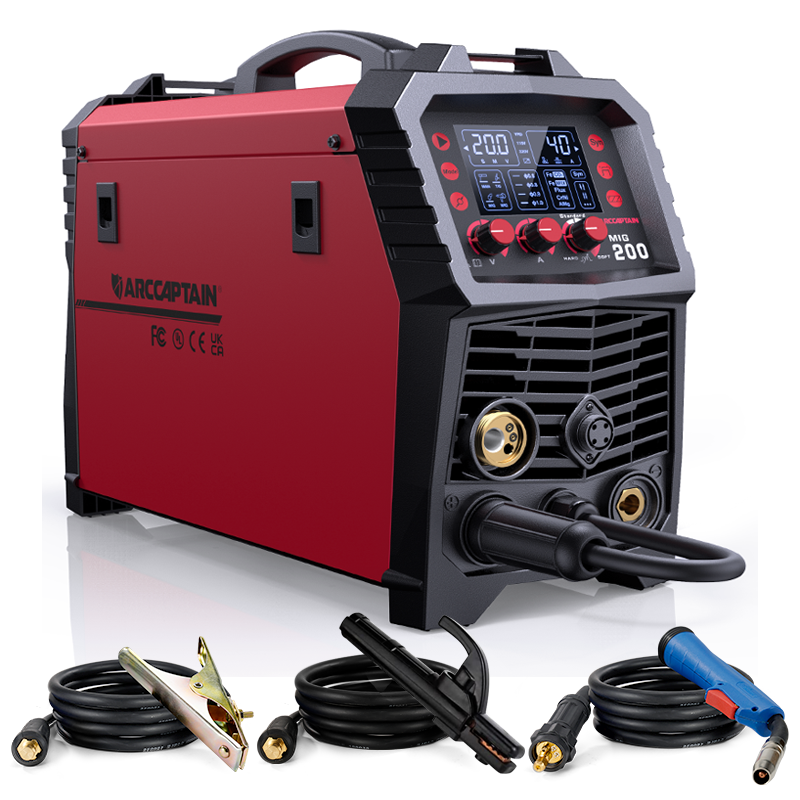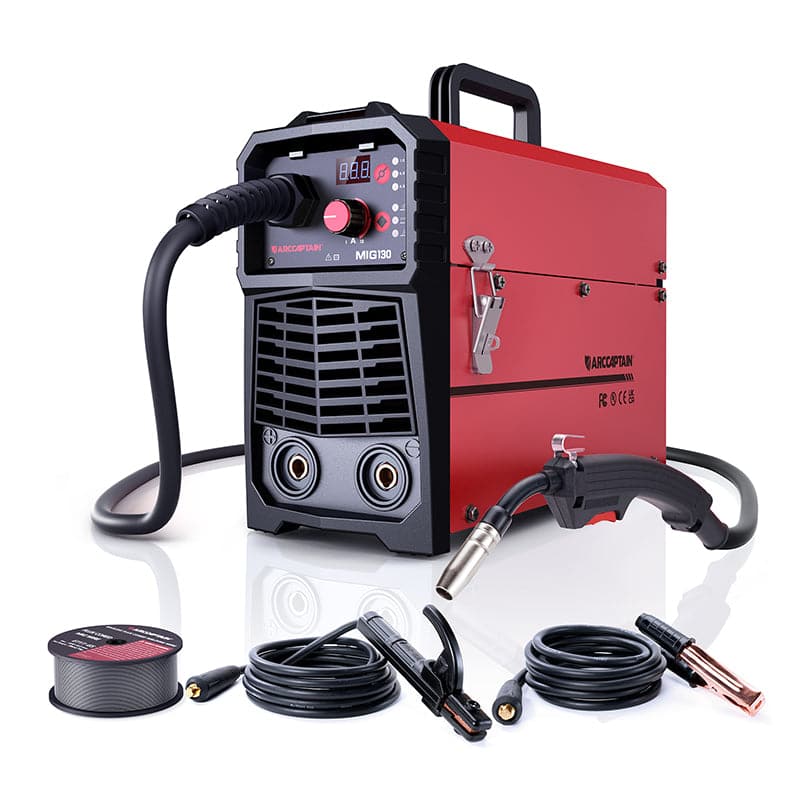
When something breaks around the house, it's essential to address the issue promptly to maintain your home's condition. While simple tools like pliers and screwdrivers can fix minor problems, more serious issues require a welding machine, such as a MIG welder. This tool is a crucial addition to your repair arsenal, as it can effectively resolve a wide range of household problems.
ArcCaptain provides a variety of MIG welding machines tailored to different work demands and price points, ensuring that you receive the best value for your needs. Whether you require a machine for house repairs, DIY welding work, welding art, or regular welding shop tasks, it's important not to overspend on a heavy-duty machine if it's unnecessary. Conversely, for more demanding tasks, a reliable MIG welder with advanced features is essential to maintain work quality without compromise.
At ArcCaptain, we strive to offer welders the best quality-price ratio, ensuring that you can acquire a quality machine that meets your needs without breaking the bank. Before delving into the specific machines, it's important to gain an understanding of MIG welding techniques.
What Is MIG Welding
MIG welding is a type of arc welding that involves the use of a continuous solid wire as the electrode and added material. The process is also known as Gas Metal Arc Welding (GMAW) because it uses a shielding gas to protect the weld pool from atmospheric contamination. MIG welding is one of the most popular welding methods for industrial use, particularly for welding sheet metal and in the automotive industry.
The MIG welding process involves feeding the solid wire electrode through a welding gun and into the weld pool, where an electric arc is created to melt the base materials together. The welding gun also provides the shielding gas to protect the weld pool from contamination. MIG welding is an indoor process and is not suitable for outdoor welding due to the risk of wind disrupting the shielding gas.
MIG welding is suitable for welding a variety of materials, including mild steel, stainless steel, and aluminum. The thickness of the material being welded will determine the voltage and wire feed speed required for the job. A chart can be used to determine the correct settings for the specific material and thickness being welded.
The MIG welding process can be used for a variety of welding joints, including butt joints, lap joints, and T-joints. The weld bead and penetration can be controlled by adjusting the wire feed speed, amperage, and gas flow. The motion of the welding gun, travel angle, and work angle can also affect the quality of the weld.
When MIG welding, it is important to clean the material before welding to ensure a good weld. A grinder can be used to remove any rust, paint, or scale from the material. The wire diameter, stick-out, and type of metal being welded will also affect the quality of the weld.
In summary, MIG welding is a versatile welding process that can be used for a variety of materials and welding joints. It is an indoor process that requires a welding machine, welding gun, wire feeder, and ground clamp. The correct settings for the specific material and thickness being welded can be determined using a chart. Cleanliness of the material and proper adjustments of the welding gun and wire feed speed are crucial for a good weld.
ArcCaptain MIG Welders Collection
ArcCaptain offers a range of MIG welders tailored to various welding needs and workloads. Each welder is designed with features to assist in your work and provide versatility.
ARCCAPTAIN MIG200 Multi Process MIG Welder 200 Amps 110/220V Aluminium Welder

- Multi-Process MIG200 : Gasless Wire Welder/MIG Welder/Stick welder/Lift TIG welder/Spot welder/Aluminium welder with spool gun.
- Easy to use,Friendly to beginners
- Leading SYN/Inverter Technology
- Fan-on-demand: a cooling fan that only runs when necessary.
- Burn-back adjustment: pre-flow/post-flow functions will help you improve welding efficiency.
- Easy to find replacement parts
- Light Weight|Ultra Portable: only 28.2 lbs, easy to carry and travel with. Great for repair jobs around the house or farm
- Buy with Confidence& 2-Year Warranty
ARCCAPTAIN MIG130 Best 3 in 1 110V Portable No Gas Flux Core Welder

- 3 in 1 No Gas Mig Welder
- Compact & Portable : Only 11.79 lbs.
- Easy to use
- 2-YEAR WARRANTY
- Out-of-the-box.Free 2 lbs Flux Cored Wire
- 0.030''- 0.118 inch Steel, support 3/32"- 1/8" inch Electrode
Summary
MIG welding is an easy-to-learn welding technique that is suitable for both professionals and beginners. It is important to prioritize safety before tackling any welding project. Basic welding safety apparel includes leather shoes or boots, cuff-less full-length pants, a flame-resistant and long-sleeve jacket, leather gloves, a welding helmet, safety glasses, and a skull cap to protect the top of your head.
When selecting a MIG welding machine, you have a range of options to choose from based on your budget and needs. Welding machines can often be overpriced, but we strive to provide quality equipment at reasonable prices. If there are any issues with the machine or you are not satisfied with it, we offer a 30-day return policy and will work with you to find a solution.
In case of any damage or issues with the machine during transport, we will provide assistance and send spare parts or work with you to fix it. Our goal is to push the boundaries in the welding world and provide quality equipment with exceptional customer support.
Frequently Asked Questions
What equipment is required for MIG welding?
To perform MIG welding, you will need a few essential equipment components. These include a MIG welding machine, a wire feeder, a welding gun, a ground clamp, and a shielding gas. The MIG welding machine is responsible for creating an electrical current that melts the metal and fuses it together. The wire feeder feeds the welding wire through the welding gun, which is used to direct the flow of the melted metal. The ground clamp is used to complete the electrical circuit, and the shielding gas is used to protect the weld from contamination.
What type of gas is commonly used in MIG welding, and why?
Argon and carbon dioxide (CO2) are the most commonly used gases in MIG welding. Argon is used for welding non-ferrous metals, such as aluminum, while CO2 is used for welding mild steel. These gases are used to protect the weld from atmospheric contaminants and to prevent oxidation, which can weaken the weld.
How do you properly set up a MIG welding machine before starting a weld?
To set up a MIG welding machine, you must first select the appropriate wire and shielding gas for the material you will be welding. Once you have selected the appropriate materials, you can set the wire feed speed, voltage, and amperage on the machine to ensure that the weld is strong and consistent. It is also important to ensure that the machine is properly grounded and that you have the appropriate safety equipment, such as gloves and a welding helmet.
What are the primary advantages and disadvantages of using MIG welding compared to other methods?
MIG welding has several advantages over other welding methods, including its speed, versatility, and ease of use. MIG welding is also capable of producing high-quality welds with minimal distortion. However, MIG welding also has some disadvantages, including its limited ability to weld thick materials and its susceptibility to wind and drafts.
What safety precautions should be taken when performing MIG welding?
When performing MIG welding, it is important to take several safety precautions to protect yourself and others from potential hazards. This includes wearing appropriate safety equipment, such as a welding helmet, gloves, and protective clothing. It is also important to ensure that the work area is well-ventilated and free from flammable materials. Additionally, you should always be aware of your surroundings and avoid welding near others who may be at risk of exposure to the welding arc.
How does MIG welding differ from TIG welding in terms of technique and application?
MIG welding and TIG welding are two different welding processes that are used for different applications. MIG welding is typically used for welding thicker materials and for applications that require higher welding speeds. TIG welding, on the other hand, is typically used for welding thinner materials and for applications that require a high degree of precision. Additionally, MIG welding uses a consumable wire electrode, while TIG welding uses a non-consumable tungsten electrode.
